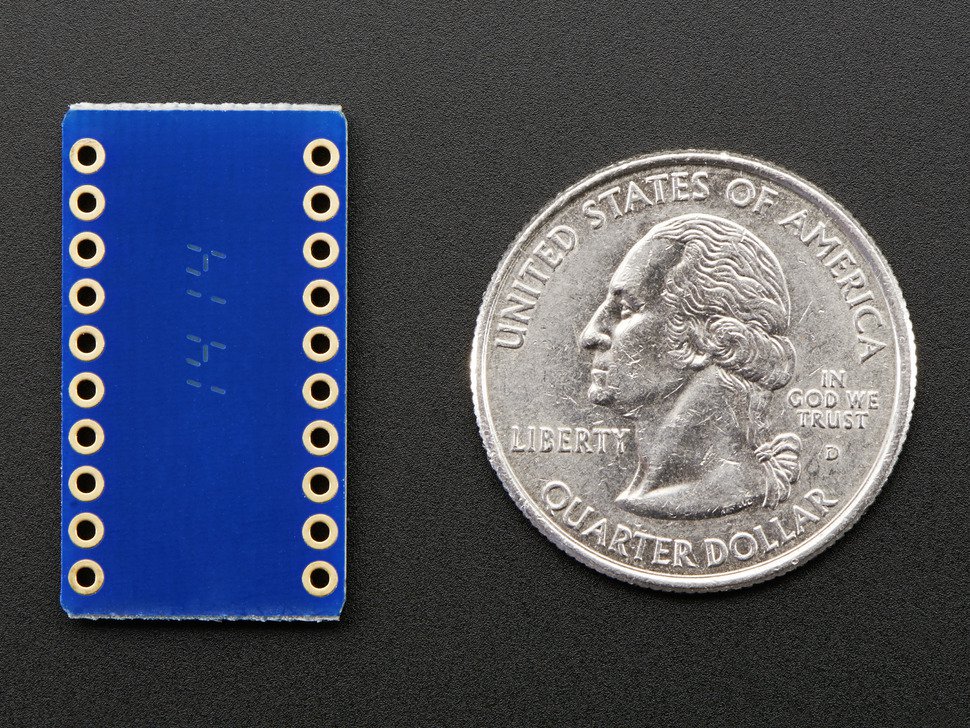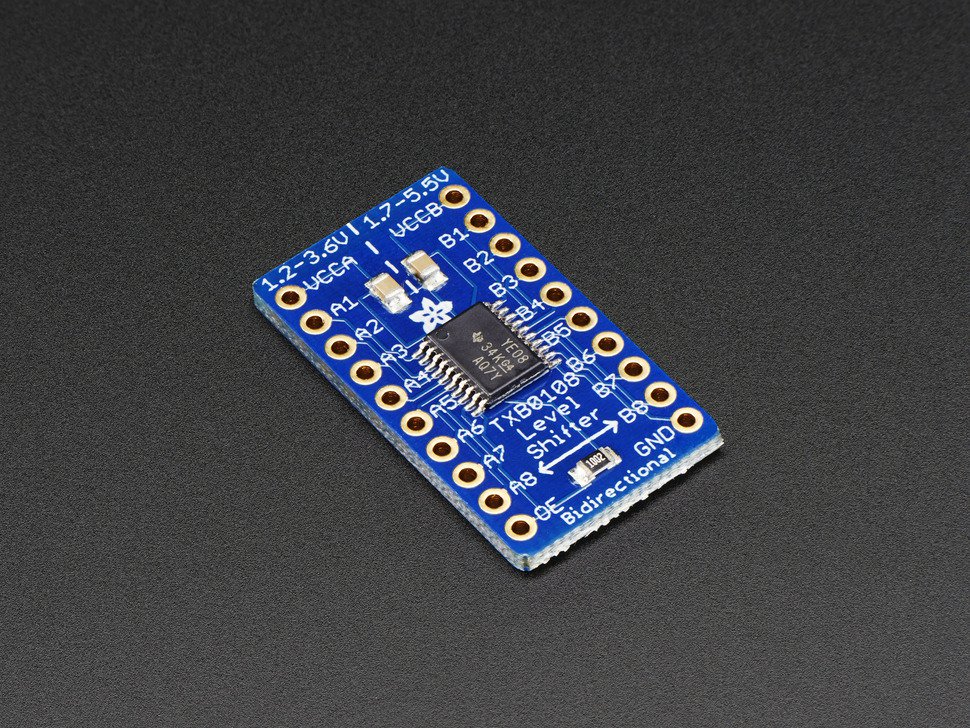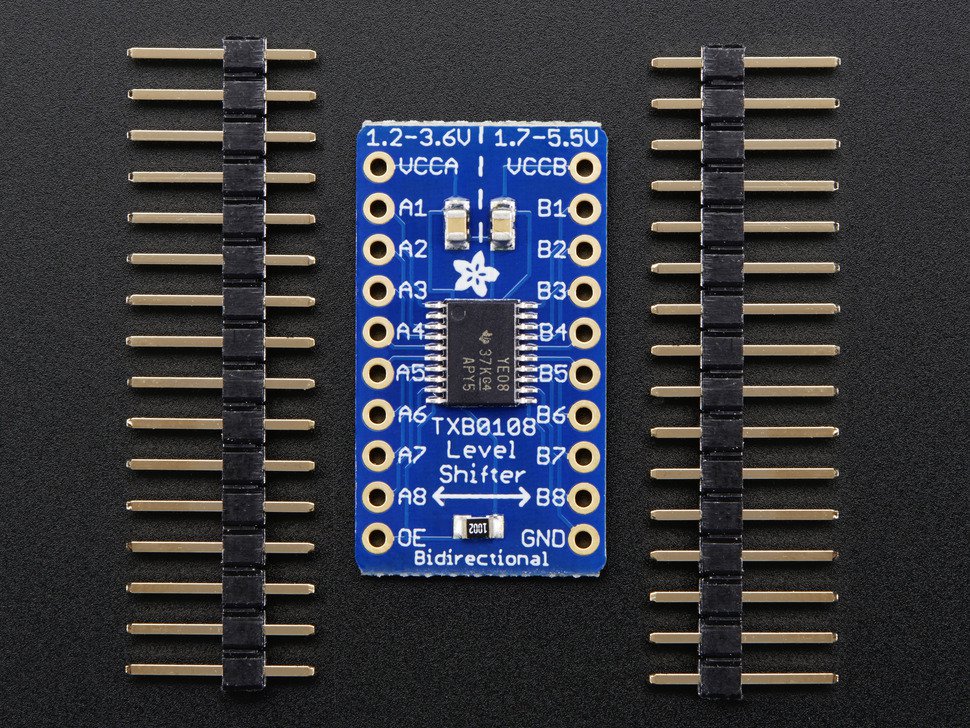8-channel Bi-directional Logic Level Converter - TXB0108
Da der Arduino (und Basic Stamp) 5V-Geräte sind und die meisten modernen Sensoren, Displays, Flash-Karten und Modi nur 3,3V benötigen, müssen viele Hersteller eine Pegelverschiebung/-umwandlung durchführen, um das 3,3V-Gerät vor 5V zu schützen.
Zwar kann man mit Widerständen einen Teiler bilden, aber bei Hochgeschwindigkeitsübertragungen können die Widerstände eine Menge Schwankungen verursachen, die schwer zu beheben sind. Aus diesem Grund verwenden wir gerne die Serie 4050/74LVX245 und ähnliche Logikbausteine, um eine korrekte Pegelverschiebung durchzuführen. Das einzige Problem ist, dass sie nur in eine Richtung funktionieren, was für einige spezielle bi-diektionale Schnittstellen ein Problem darstellen kann und die Verdrahtung etwas schwierig macht.
Hier kommt dieser schöne Chip ins Spiel, der TXB0108, ein bidirektionaler Pegelwandler! Dieser Chip führt eine bidirektionale Pegelverschiebung von so ziemlich jeder Spannung zu jeder Spannung durch und erkennt die Richtung automatisch. Das einzige, was mit diesem Chip nicht gut funktioniert, ist i2c (weil er starke Pullups verwendet, die den Sensor für die automatische Richtungserkennung verwirren). Wenn Sie Pullups verwenden müssen, können Sie das tun, aber sie sollten mindestens 50K Ohm haben - die internen Pullups von AVRs/Arduino haben etwa 100K Ohm, also sind sie OK! Er ist ein wenig luxuriöser als ein 74LVX245, aber wenn man sich keine Gedanken über Richtungspins machen will, ist er ein Lebensretter!
Da dieser Chip ein spezieller bidirektionaler Level Shifter ist, hat er keine starken Ausgangspins, die LEDs oder lange Kabel treiben können, er ist dafür gedacht, auf einem Breadboard zwischen zwei Logikchips zu sitzen! Wenn Sie keine sofortige bidirektionale Unterstützung benötigen, empfehlen wir den 74LVX245 (siehe unten), der einen starken Ausgang hat.
Dieses Breakout erspart Ihnen das Löten der sehr feinen Pitch-Gehäuse, mit denen dieser Chip geliefert wird. Wir fügen außerdem 0,1uF-Kappen auf beiden Seiten und einen 10K-Pull-up-Widerstand am Ausgangs-Enable-Pin hinzu, damit Sie den Chip sofort verwenden können!
- TXB0108-Datenblatt
- TXB0108 App-Notiz mit detaillierter Beschreibung der Funktionsweise!
- EagleCAD PCB-Dateien auf GitHub
- Fritzing-Objekt in der Adafruit Fritzing-Bibliothek
English Description
8-channel Bi-directional Logic Level Converter - TXB0108
Because the Arduino (and Basic Stamp) are 5V devices, and most modern sensors, displays, flash cards and modes are 3.3V-only, many makers find that they need to perform level shifting/conversion to protect the 3.3V device from 5V.
Although one can use resistors to make a divider, for high speed transfers, the resistors can add a lot of slew and cause havoc that is tough to debug. For that reason, we like using 4050/74LVX245 series and similar logic to perform proper level shifting. Only problem is that they are only good in one direction which can be a problem for some specialty bi-diectional interfaces and also makes wiring a little hairy.
That's where this lovely chip, the TXB0108 bi-directional level converter comes in! This chip perform bidirectional level shifting from pretty much any voltage to any voltage and will auto-detect the direction. Only thing that doesn't work well with this chip is i2c (because it uses strong pullups which confuse auto-direction sensor). If you need to use pullups, you can but they should be at least 50K ohm - the ones internal to AVRs/Arduino are about 100K ohm so those are OK! Its a little more luxurious than a 74LVX245 but if you just don't want to worry about directional pins this is a life saver!
Since this chip is a special bi-directional level shifter it does not have strong output pins that can drive LEDs or long cables, it's meant to sit on a breadboard between two logic chips! If you do not need instant bi-directional support, we suggest the 74LVX245 as below which has strong output drive.
This breakout saves you from having to solder the very fine pitch packages that this chip comes with. We also add 0.1uF caps onto both sides and a 10K pull-up resistor on the output enable pin so you can use it right out of the box!
- TXB0108 Datasheet
- TXB0108 App note detailing how it works!
- EagleCAD PCB files on GitHub
- Fritzing object in Adafruit Fritzing library
Sicherheitsangaben
- Lesen Sie die Bedienungsanleitung sorgfältig durch, bevor Sie das Produkt verwenden.
- Stellen Sie sicher, dass alle Montage- und Installationsanweisungen des Herstellers sorgfältig befolgt werden.
- Verwenden Sie das Produkt nur für den vorgesehenen Zweck.
- Die unsachgemäße Nutzung dieses Produkts kann zu schweren Verletzungen oder Sachschäden führen.
- Nicht für Kinder unter 10 Jahren geeignet.
- Bei unsachgemäßer Verwendung besteht eine Verletzungsgefahr.
- Dieses Produkt entspricht den geltenden Sicherheitsanforderungen der Europäischen Union.
- Dieses Produkt wurde gemäß der GPSR geprüft, die sicherstellt, dass alle relevanten Sicherheitsanforderungen für Konsumgüter eingehalten werden.
Nachverfolgbarkeitsinformationen
Jedes Produkt verfügt über eines oder mehrere der folgenden Merkmale:
- Ein CE-Kennzeichen, das die Einhaltung der Sicherheits-, Gesundheits- und Umweltschutzanforderungen der Europäischen Union anzeigt.
- Eine eindeutige Serien- oder Chargennummer, um die Nachverfolgbarkeit zu gewährleisten und bei Bedarf Rückrufaktionen zu unterstützen.
- Hersteller- und Importeurangaben für den Kundensupport und Sicherheitsanfragen.
Überwachung und Berichterstattung von Vorfällen
Für den unwahrscheinlichen Fall eines Produktproblems haben wir Verfahren implementiert, um:
- Kundenbeschwerden zeitnah bearbeiten.
- Schwerwiegende Vorfälle über das EU Safety Gate/RAPEX-System melden.
- Mit den Marktüberwachungsbehörden zusammenarbeiten, um die öffentliche Sicherheit zu gewährleisten.
Kontakt:
- Email: support [@] pi3g.com
- Telefon: 0341 / 392 858 40
Dieses Produkt ist vollständig mit allen geltenden EU-Vorschriften konform, um die Sicherheit unserer geschätzten Kunden zu gewährleisten.



